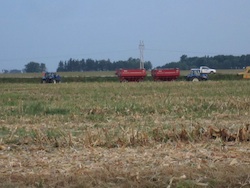The United States Department of Agriculture (USDA) released its final report on the total 2010 corn crop and supply and well as its updated estimates of corn use. The total 2010 corn production was 12.45 billion bushels, the third largest crop in U.S. history.
 There were some unanticipated changes in the report as well. First, the corn yield was lower – 152.8 bushels per acre but overall, this is still the 4th highest. The reduction in yield was offset by the addition of 100,000 harvested acres. Second, the USDA increased its demand forecast to 4.9 billion bushels for the marketing year that runs from September 1, 2010 through August 31, 2011. This should equal ethanol production of nearly 13.5 billion gallons. When taking into account the contribution of distillers grains and other feed co-products of ethanol production, USDA lowered its livestock feed usage by 100 million bushels.
There were some unanticipated changes in the report as well. First, the corn yield was lower – 152.8 bushels per acre but overall, this is still the 4th highest. The reduction in yield was offset by the addition of 100,000 harvested acres. Second, the USDA increased its demand forecast to 4.9 billion bushels for the marketing year that runs from September 1, 2010 through August 31, 2011. This should equal ethanol production of nearly 13.5 billion gallons. When taking into account the contribution of distillers grains and other feed co-products of ethanol production, USDA lowered its livestock feed usage by 100 million bushels.
Ending stocks of corn were reported at 745 million bushels, down from last month’s report.
The Renewable Fuels Association (RFA) took time to analyze the report and determine how it may impact the ethanol industry. They stated, “While not as large as originally thought, the 2010 corn crop is quite robust considering the challenges much of the Corn Belt endured. With the 4th highest yields and 3rd largest crop on record, American farmers once again demonstrated their ability to produce a safe and abundant corn supply.”
RFA also noted that USDA kept their ethanol production estimates for the 2010/2011 marketing year in line with industry expectations. The organization also thinks it highly unlikely that the USDA will reverse their numbers in the future, especially in a higher direction due to the constraints of the E10 blend wall and the anticipated slow adoption of E15 ethanol blends.
 Although domestic corn supplies are lower than the record supply achieved last year, global supplies of food grains like rice and wheat, grains most often used for human consumption, remain strong. RFA believes this report will “undoubtedly be like catnip for speculators that will predictably seek to drive commodity markets higher.” They based their theory on the fact that this very scene played out before in 2007/2008 when all commodities, led by oil, soared to unsustainable levels. RFA predicts “enthusiastic Malthusians and other doomsday prognosticators will use this report to blame biofuels for food insecurities that have existed for decades.”
Although domestic corn supplies are lower than the record supply achieved last year, global supplies of food grains like rice and wheat, grains most often used for human consumption, remain strong. RFA believes this report will “undoubtedly be like catnip for speculators that will predictably seek to drive commodity markets higher.” They based their theory on the fact that this very scene played out before in 2007/2008 when all commodities, led by oil, soared to unsustainable levels. RFA predicts “enthusiastic Malthusians and other doomsday prognosticators will use this report to blame biofuels for food insecurities that have existed for decades.”
RFA concluded, “The fact remains global supplies of grains remain sufficient to meet needs. Instead of casting blame, we should be investing in technologies that will help farmers in developing nations improve their productivity. We should also focus more intently on helping developing nations invest in renewable fuels and other technologies that mitigate climate change impacts and incentive more efficient and productive farming practices.”
CEO Tom Buis of Growth Energy added, “Today’s report, while smaller than expected, is still the third largest corn crop on record and proves once again the tremendous capability of American farmers to meet our growing demand for food, feed and renewable fuel – even during challenging growing conditions. There is plenty of potential to produce more, both here and worldwide. American farmers have shown time and time again their ability to meet the demands of the marketplace.”

